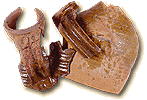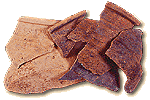![]() Ceramics
Ceramics

 Pottery
vessels served many purposes both in the kitchen and the great halls of the
wealthy, and in the cottages of the poor. It was mass produced, relatively
cheap and widely available through most of Norman England. Simple unglazed
vessels of all sizes were used in the preparation of food while jugs with
glaze or decoration served wine or ale at the table. Other forms include storage
vessels, lamps and bowls and, as the period progressed, the range of shapes
and their functions increased.
Pottery
vessels served many purposes both in the kitchen and the great halls of the
wealthy, and in the cottages of the poor. It was mass produced, relatively
cheap and widely available through most of Norman England. Simple unglazed
vessels of all sizes were used in the preparation of food while jugs with
glaze or decoration served wine or ale at the table. Other forms include storage
vessels, lamps and bowls and, as the period progressed, the range of shapes
and their functions increased.
 This
period saw a great expansion in the number of pottery production centres,
whose output was much greater than before. Many of these centres were located
in villages and in the countryside, rather than, as in Anglo-Saxon times,
in the towns where the risk of fire needed to be taken seriously. Potteries
were now nearer their sources of fuel and clay, and their products were sold
in the towns or by travelling merchants in the countryside.
This
period saw a great expansion in the number of pottery production centres,
whose output was much greater than before. Many of these centres were located
in villages and in the countryside, rather than, as in Anglo-Saxon times,
in the towns where the risk of fire needed to be taken seriously. Potteries
were now nearer their sources of fuel and clay, and their products were sold
in the towns or by travelling merchants in the countryside.
 With
the expansion in production came a flowering of style and technique. There
had been some earlier experimenting with glazing as a technique for decorating
pottery but after the Conquest glazed pottery became much more common. At
first glaze was applied as splashes to jugs and table wares to form a simple
embellishment, but as skills developed, lavishly decorated jugs were produced.
Different types of glaze were used and, when combined with elaborate decorative
patterns, the results were often very beautiful. Fine wares were imported
from France and were copied both for their technology and their style, both
of which were more advanced than in England.
With
the expansion in production came a flowering of style and technique. There
had been some earlier experimenting with glazing as a technique for decorating
pottery but after the Conquest glazed pottery became much more common. At
first glaze was applied as splashes to jugs and table wares to form a simple
embellishment, but as skills developed, lavishly decorated jugs were produced.
Different types of glaze were used and, when combined with elaborate decorative
patterns, the results were often very beautiful. Fine wares were imported
from France and were copied both for their technology and their style, both
of which were more advanced than in England.